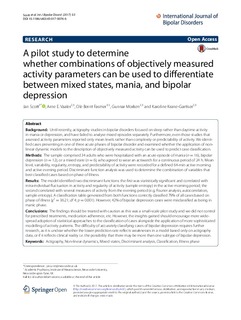| dc.contributor.author | Scott, Janine Linda | |
| dc.contributor.author | Vaaler, Arne | |
| dc.contributor.author | Fasmer, Ole Bernt | |
| dc.contributor.author | Morken, Gunnar | |
| dc.contributor.author | Krane-Gartiser, Karoline | |
| dc.date.accessioned | 2017-12-07T07:36:03Z | |
| dc.date.available | 2017-12-07T07:36:03Z | |
| dc.date.created | 2017-03-15T09:36:22Z | |
| dc.date.issued | 2017 | |
| dc.identifier.citation | International journal of bipolar disorders. 2017, 5 (5), 1-8-?. | nb_NO |
| dc.identifier.issn | 2194-7511 | |
| dc.identifier.uri | http://hdl.handle.net/11250/2469460 | |
| dc.description.abstract | Background
Until recently, actigraphy studies in bipolar disorders focused on sleep rather than daytime activity in mania or depression, and have failed to analyse mixed episodes separately. Furthermore, even those studies that assessed activity parameters reported only mean levels rather than complexity or predictability of activity. We identified cases presenting in one of three acute phases of bipolar disorder and examined whether the application of non-linear dynamic models to the description of objectively measured activity can be used to predict case classification.
Methods
The sample comprised 34 adults who were hospitalized with an acute episode of mania (n = 16), bipolar depression (n = 12), or a mixed state (n = 6), who agreed to wear an actiwatch for a continuous period of 24 h. Mean level, variability, regularity, entropy, and predictability of activity were recorded for a defined 64-min active morning and active evening period. Discriminant function analysis was used to determine the combination of variables that best classified cases based on phase of illness.
Results
The model identified two discriminant functions: the first was statistically significant and correlated with intra-individual fluctuation in activity and regularity of activity (sample entropy) in the active morning period; the second correlated with several measures of activity from the evening period (e.g. Fourier analysis, autocorrelation, sample entropy). A classification table generated from both functions correctly classified 79% of all cases based on phase of illness (χ 2 = 36.21; df 4; p = 0.001). However, 42% of bipolar depression cases were misclassified as being in manic phase.
Conclusions
The findings should be treated with caution as this was a small-scale pilot study and we did not control for prescribed treatments, medication adherence, etc. However, the insights gained should encourage more widespread adoption of statistical approaches to the classification of cases alongside the application of more sophisticated modelling of activity patterns. The difficulty of accurately classifying cases of bipolar depression requires further research, as it is unclear whether the lower prediction rate reflects weaknesses in a model based only on actigraphy data, or if it reflects clinical reality i.e. the possibility that there may be more than one subtype of bipolar depression. | nb_NO |
| dc.language.iso | eng | nb_NO |
| dc.publisher | Springer Open | nb_NO |
| dc.rights | Navngivelse 4.0 Internasjonal | * |
| dc.rights.uri | http://creativecommons.org/licenses/by/4.0/deed.no | * |
| dc.title | A pilot study to determine whether combinations of objectively measured activity parameters can be used to differentiate between mixed states, mania, and bipolar depression. | nb_NO |
| dc.type | Journal article | nb_NO |
| dc.type | Peer reviewed | nb_NO |
| dc.description.version | publishedVersion | nb_NO |
| dc.source.pagenumber | 1-8-? | nb_NO |
| dc.source.volume | 5 | nb_NO |
| dc.source.journal | International journal of bipolar disorders | nb_NO |
| dc.source.issue | 5 | nb_NO |
| dc.identifier.doi | 10.1186/s40345-017-0076-6 | |
| dc.identifier.cristin | 1458438 | |
| dc.description.localcode | © The Author(s) 2017. This article is distributed under the terms of the Creative Commons Attribution 4.0 International License (http://creativecommons.org/licenses/by/4.0/), which permits unrestricted use, distribution, and reproduction in any medium, provided you give appropriate credit to the original author(s) and the source, provide a link to the Creative Commons license, and indicate if changes were made. | nb_NO |
| cristin.unitcode | 194,65,35,0 | |
| cristin.unitname | Institutt for psykisk helse | |
| cristin.ispublished | true | |
| cristin.fulltext | original | |
| cristin.qualitycode | 1 | |

